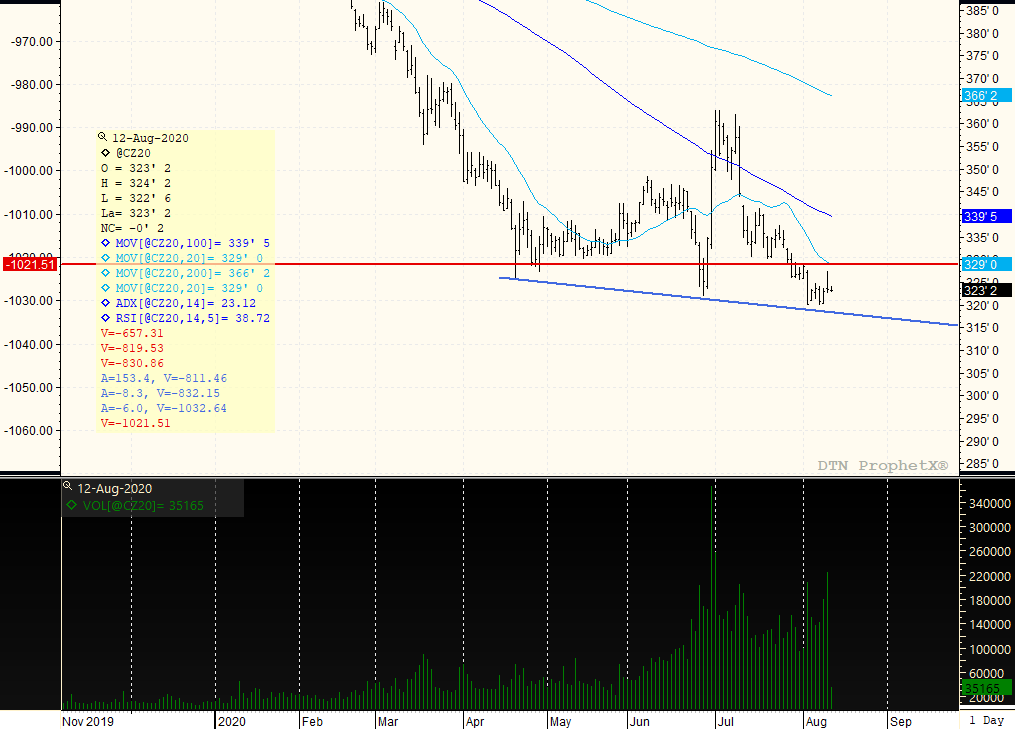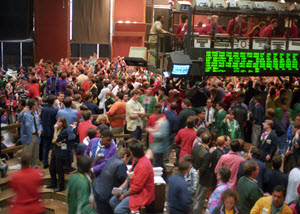GOOD MORNING,
Prices are mixed heading into trade with a recovery in soyoil. The August 12 WASDE, which includes the use of farmer surveys, is out at 11:00 central time. Funds enter the report short corn, wheat, and meal, long soyoil and beans. Expectations are for higher corn and bean yield and production. Traders expect to see larger world wheat production figures based on growing numbers in Russia, Canada, and Australia. After the close, we get the first FSA acreage data that will offer the first official look at prevent plant figures as well as certified acres.
Corn prices are steady as Iowa Ag officials estimated that as much as 10 million acres and ton of bushels of storage were impacted by the storms this week. Cash basis continues to firm, which is triggering new bull-spreading. Farmers remain disengaged from the market given current prices.
Beans continue to trade sideways with resistance provided by a healthy crop as conditions remain good in August. China continues under the market with chatter that they have been making more inquiries this week despite negative rhetoric. The US-China bilateral communication on August 15 is said to be a check-in event, though China may want to talk about recent events such as TikTok and other social media.
WEATHER
Mostly favorable conditions are noted for filling beans in the Midwest. There are cooler temperatures and continued chances for scattered rainfall events throughout the balance of this week. Dry spots remain in the central Delta, with stress to pod setting and filling beans.
ANNOUNCEMENTS
The EU has re-introduced an import duty for corn, setting a levy of $6.42/ton. The tariff will apply to rye and sorghum imports as well.
Data released Monday by Brazil's Foreign Trade Secretariat, (Secex), indicates that corn exports reached 2 mmt for the first week of August and exceeded bean shipments in this period. The daily average of corn shipments went from 332,800 tons in August 2019 to 408,500 tons in the first five working days of this month. For soy, exports totaled 1.59 mln tons, with a daily average of 318,700 tons.
Ukraine's UGA lowered its 2020 corn harvest forecast to 36.4 mln mt, down 2.5 mln mt from their prior forecast. They attributed the reduction to dry weather conditions that impacted yields.
DELIVERIES
Meal: 182
CALLS
Calls are as follows:
beans: mixed/lower
meal: mixed/lower
soyoil: 20-25 higher
corn: 1/2 lower
wheat: 3-4 lower
OUTSIDE MARKETS
Higher crude oil, which trades up to $42.35/barrel, and a weaker US dollar at 93.48. Stocks are up 250 pts.
TECH TALK
- December soyoil prices break down further after triggering sell-stops under the 200-day moving average of 3050c. However, prices have rebounded off those lows, as the major trend has been higher. The ability to trade higher from lower does show inherent market strength, and if short would probably cover and go long. Dec. trading range is from 30c to possible highs of 32c.
- December meal prices triggered a key reversal which led to more short-covering and price stability. The gains gathered from the outside day closing higher took prices towards $295.00, and the market may begin to print a $286.20 - $300.00 trading range.
- November beans remain sideways in a familiar $8.65-$8.85 trading range heading into today's number. The major direction has been lower, but in the past the 100-day moving average at $8.68 has been the bottom of the market. The lack of a clear trend denoted by the ADX of 15 suggests that prices can continue to hold on a break, while trade back over $8.77 paves the way for trade back to $8.90. Would prefer to still buy breaks in this market until a better down-trend forms.
- December corn prices continue to congest above $3.20. Momentum has turned sideways from lower, which allows for $3.20 to become a base of support. Longer term support lines drawn off April will give further support to the $3.17 level, should we get there.
- September wheat prices fail at $4.98 and return to market lows of $4.90. If short, could cover some and keep the rest as returning often to lows suggests that prices will eventually go beneath them. The chart is trying to base at $4.90, and today would be a good case to see if it can hold. The low end close, however, suggests that we may be taking a look at the $4.85-$4.88 level after we open again.
DECEMBER CORN
The major direction is lower, and the spike high up to $3.27 gave way to lower price action once again. Returning to market lows is never a sign of strength, and increases the chance for a larger break. However, if prices do break $3.20 there is long term support drawn off April lows which cross at $3.17. If so, we could begin to work into a $3.17-$3.27 trading range. Seasonally corn can post its season low in or around the August report. While there is not a reversal signal off the low, today's report and price action could determine a trend over the next several weeks. A close over $3.30 would need to occur which could kick off a larger rally over time.

ON THE CALENDAR
The EIA report will be released this morning, with advertised expectations for production is expected to be up 1% and stocks down 1%.
TAGS – Feed Grains, Soy & Oilseeds, Wheat, North America



 Last Friday, 19 April, the EPA issued an emergency waiver for E15 to be sold through the summer driving season. The topline takeaway of that action is positive for the ethanol sector, but the practicality of implementing the new rule is more complex. Indeed, the structure of the Cle...
Last Friday, 19 April, the EPA issued an emergency waiver for E15 to be sold through the summer driving season. The topline takeaway of that action is positive for the ethanol sector, but the practicality of implementing the new rule is more complex. Indeed, the structure of the Cle...
 Regional Updates MEDITERRANEAN/MIDDLE EAST/NORTH AFRICA/AFRICA – MEA REGION Iran, Bangladesh, and the UAE were major destinations for Indian soymeal exports in March 2024, representing 78 percent of exports – Bangladesh 33,000 MT, Iran 88,000 MT, and UAE 18,000 MT. Iran imported 429...
Regional Updates MEDITERRANEAN/MIDDLE EAST/NORTH AFRICA/AFRICA – MEA REGION Iran, Bangladesh, and the UAE were major destinations for Indian soymeal exports in March 2024, representing 78 percent of exports – Bangladesh 33,000 MT, Iran 88,000 MT, and UAE 18,000 MT. Iran imported 429...
 Friday’s strength in CBOT and broader global ag commodity futures was simply a foreshadowing of the rallies that would develop on Monday. Heading into the weekend, markets were jittery on perceived weather risks, many of which turned out to be prescient. Over the weekend, parts of the U.S...
Friday’s strength in CBOT and broader global ag commodity futures was simply a foreshadowing of the rallies that would develop on Monday. Heading into the weekend, markets were jittery on perceived weather risks, many of which turned out to be prescient. Over the weekend, parts of the U.S...
 Update for 1 April 2024: Last year, users pointed out differences between the 5-year averages reported in this app and what USDA estimates in its weekly report. The difference exists because WPI calculates average based on the last 5 years of observations for the current week. In cases where ob...
Update for 1 April 2024: Last year, users pointed out differences between the 5-year averages reported in this app and what USDA estimates in its weekly report. The difference exists because WPI calculates average based on the last 5 years of observations for the current week. In cases where ob...